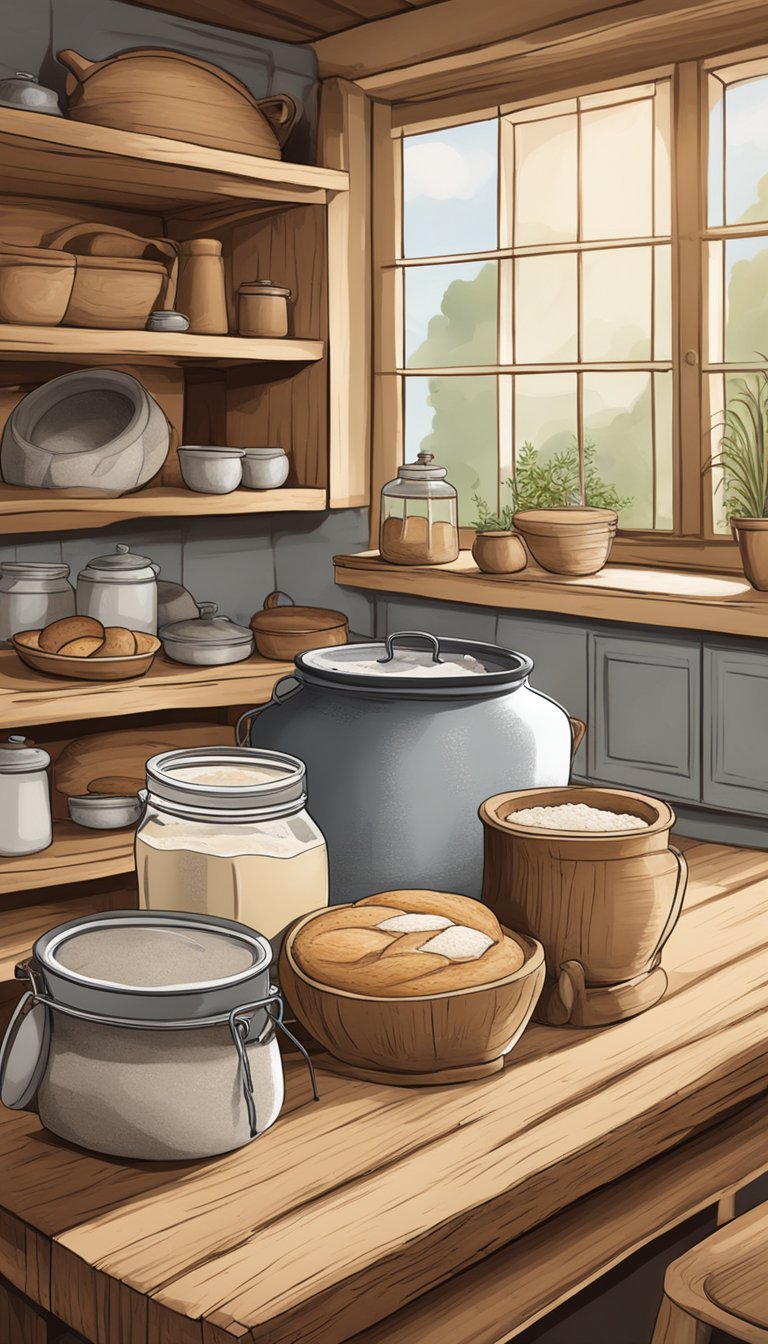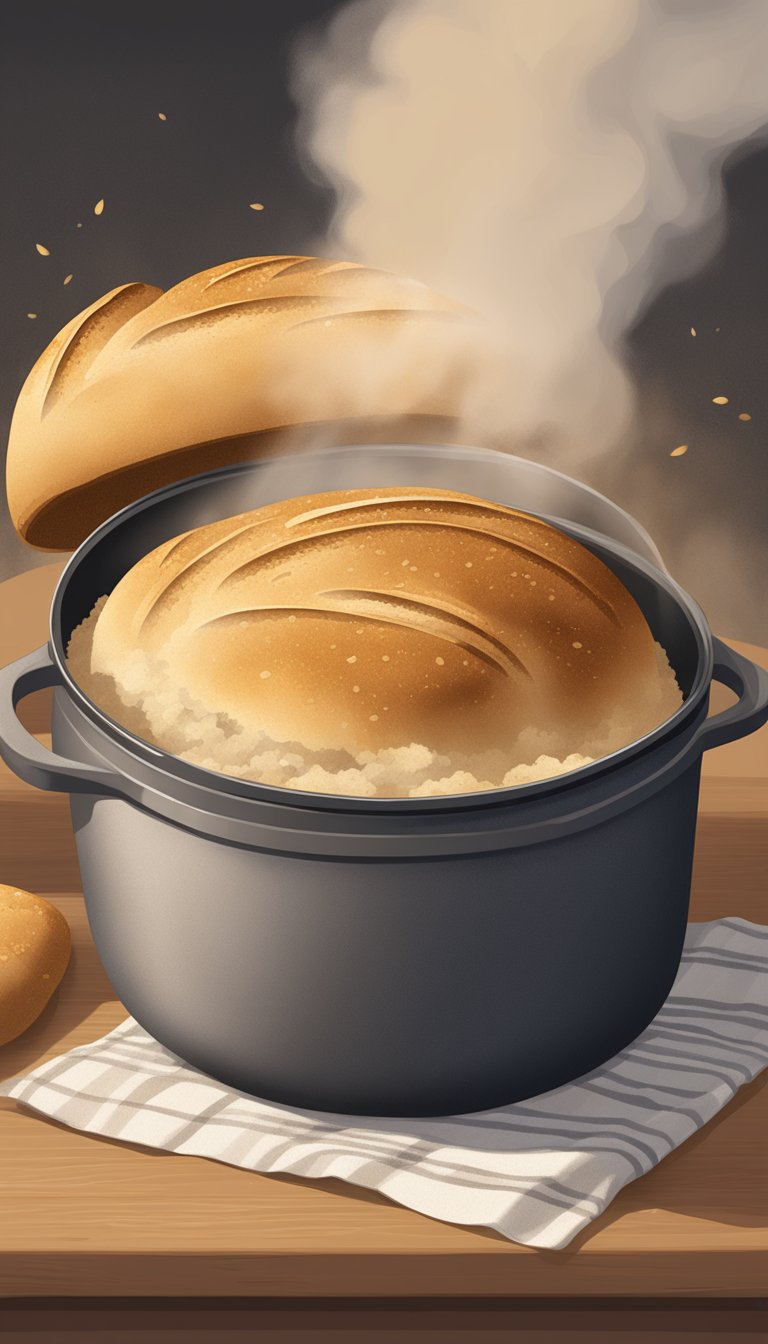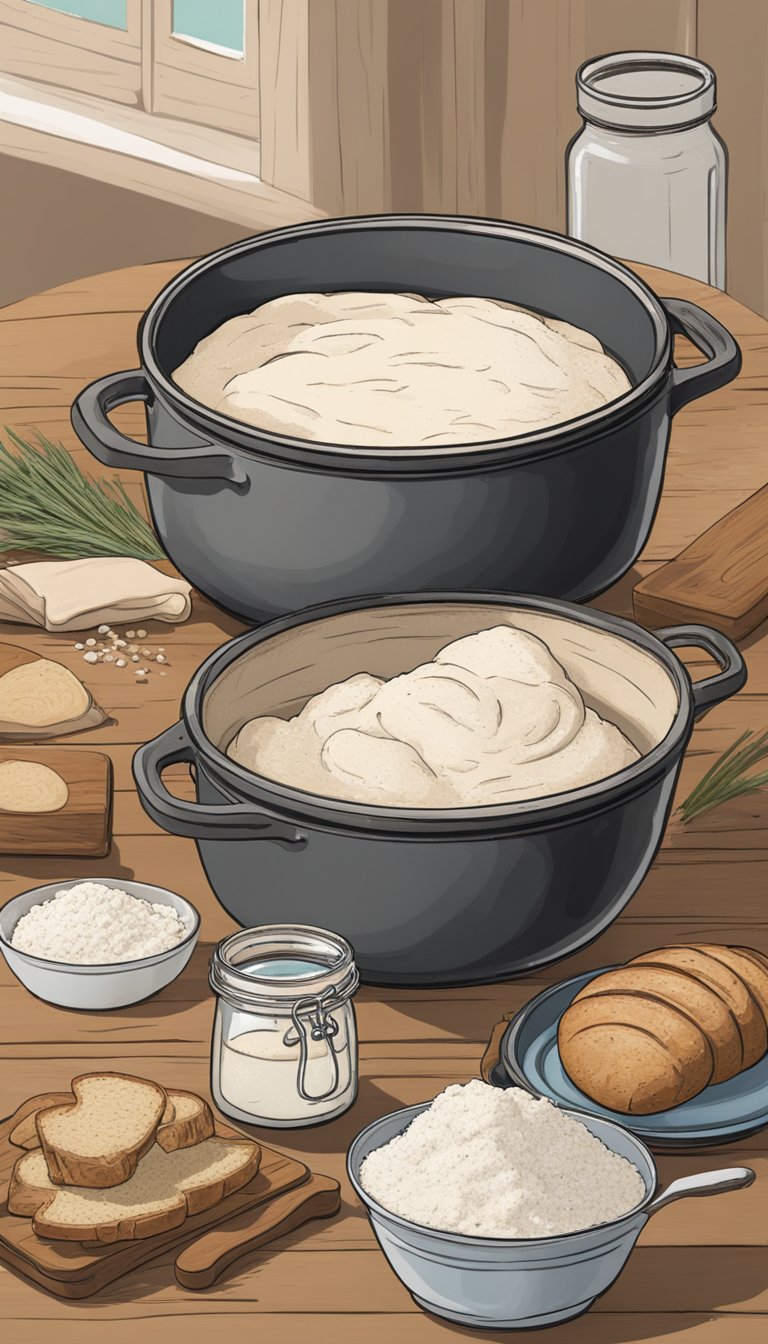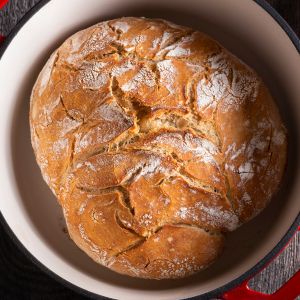If you’re a fan of freshly baked bread, then you’re probably familiar with sourdough. This type of bread is made using a sourdough starter culture that’s been fermented for several days, giving it a distinct flavor and texture. But did you know that you can also use sourdough to make other types of baked goods, including cakes, biscuits, and even pizza crusts? In this article, we’ll be focusing on a sourdough bread dutch oven recipe that’s perfect for making crusty, artisan-style bread at home.
This post may contain affiliate links.
To make sourdough bread in a dutch oven, you’ll need a few key ingredients, including flour, water, salt, and of course, your sourdough starter. You’ll also need a dutch oven, which is a heavy, lidded pot that’s perfect for baking bread. The high sides of the pot help to trap steam, which creates a moist, chewy interior and a crispy, golden crust.
Related Article: Quick Sourdough Discard Recipes
In the following paragraphs, we’ll walk you through the steps of making a sourdough dutch oven bread, from creating your starter to baking the finished loaf. Whether you’re a seasoned bread baker or a beginner looking to try something new, this recipe is sure to impress. So roll up your sleeves, dust off your apron, and let’s get started!
Sourdough Basics
Understanding Sourdough
Sourdough bread is a type of bread that uses natural yeast and bacteria to rise instead of commercial yeast. This results in a unique flavor and texture that is loved by many. Sourdough bread is also known for its long shelf life and health benefits.
Related Article: Sourdough Discard Pancakes
The Starter
To make sourdough bread, you need a sourdough starter. A sourdough starter is a mixture of flour and water that has been left to ferment for several days. During this time, the natural yeast and bacteria in the air and on the flour will begin to grow and multiply, creating a living culture.
Maintaining a sourdough starter requires regular feeding with fresh flour and water. It is important to use high-quality flour and filtered water to ensure the best possible results. A healthy sourdough starter should have a pleasant sour smell and be bubbly and active.
Flour Types
The type of flour you use in your sourdough bread can have a significant impact on the flavor and texture of the final product. Common flours used in sourdough bread include all-purpose flour, whole wheat flour, and rye flour.
All-purpose flour is a good choice for beginners as it is easy to work with and produces a mild-flavored bread. Whole wheat flour adds a nutty flavor and a denser texture to the bread. Rye flour is often used in traditional sourdough bread recipes and adds a distinct sour flavor.
Experimenting with different flour types and ratios can help you find your perfect sourdough bread recipe. Remember to always use high-quality flour and filtered water for the best results.

Gathering the Equipment
Before you start making your sourdough bread, you need to gather some essential equipment. In this section, we will discuss the tools you need to make a perfect sourdough bread in a Dutch oven.
Related Article: Sourdough Discard Blueberry Muffins
Choosing a Dutch Oven
A Dutch oven is an essential tool for baking sourdough bread. It is a heavy pot with a tight-fitting lid that can withstand high temperatures. When choosing a Dutch oven, consider the following:
- Material: Dutch ovens are made of cast iron, ceramic, or stainless steel. Cast iron is the most popular choice as it distributes heat evenly and retains heat well. Ceramic Dutch ovens are also a good option, but they are more fragile than cast iron. Stainless steel Dutch ovens are lightweight and easy to clean but are not as good at retaining heat as cast iron or ceramic.
- Size: The size of the Dutch oven depends on the size of your loaf. A 4- to 5-quart Dutch oven is suitable for a small loaf, while a 6- to 8-quart Dutch oven is ideal for a larger loaf.

Other Essential Tools
In addition to a Dutch oven, you will need some other tools to make sourdough bread. Here are some essential tools:
- Mixing bowl: You need a large mixing bowl to mix the dough.
- Dough scraper: A dough scraper is used to scrape the dough from the bowl and shape the dough.
- Parchment paper: Parchment paper is used to line the Dutch oven and prevent the bread from sticking.
With these essential tools, you are ready to make a perfect sourdough bread in a Dutch oven.
Creating Your Dough
Ingredients:
- 1 cup active sourdough starter
- 1 ½ cups warm water
- 4 cups bread flour
- 1 ½ teaspoons salt
Instructions:
- In a large mixing bowl, combine the sourdough starter and warm water.
- Add the bread flour and salt to the bowl, and mix until a shaggy dough forms.
- Cover the bowl with a clean kitchen towel and let the dough rest at room temperature for 30 minutes.
- After 30 minutes, perform a series of stretch and folds by grabbing one side of the dough, stretching it up, and then folding it over the rest of the dough. Repeat this process 4-5 times, rotating the bowl as you go.
- Cover the bowl again and let the dough rise at room temperature for 3-4 hours, performing the stretch and folds every 30 minutes during the first 2 hours.
- Once the dough has doubled in size, gently shape it into a round loaf and place it onto a piece of parchment paper.
- Preheat your oven to 450°F (232°C) and place a Dutch oven with the lid on inside to preheat as well.
- After the oven and Dutch oven have preheated, carefully transfer the dough into the preheated Dutch oven using the parchment paper as a sling.
- Cover the Dutch oven with the lid and bake for 20 minutes.
- After 20 minutes, remove the lid and continue baking for an additional 25-30 minutes, or until the bread is golden brown and sounds hollow when tapped on the bottom.
- Once baked, remove the bread from the Dutch oven and let it cool on a wire rack before slicing and serving. Enjoy your delicious sourdough Dutch oven bread!
Baking Process
Preheating Your Dutch Oven
Before you start baking, it’s important to preheat your Dutch oven. This will ensure that your bread bakes evenly and has a crispy crust. To preheat your Dutch oven, simply place it in your oven and set the temperature to 450°F (230°C). Let it heat up for at least 30 minutes before you start baking.
Related Article: Sourdough Discard Coffeecake
Scoring the Dough
Scoring your dough is an important step in the baking process. It allows the bread to expand properly while baking and creates a beautiful pattern on the crust. To score your dough, use a sharp knife or a bread lame to make shallow cuts on the surface of the dough. You can make straight lines, diagonal lines, or any other pattern you like.

Steam and Its Importance
Steam is an important factor in baking sourdough bread. It helps to create a crispy crust and prevents the bread from drying out. To create steam in your oven, you can use a few different methods. One way is to place a pan of hot water on the bottom of your oven while you bake. Another way is to spray water into the oven using a spray bottle. You can also create steam by placing a tray of ice cubes on the bottom of your oven.
Remember, the baking process can vary depending on your specific recipe and oven. Be sure to follow the instructions carefully and make adjustments as needed. With a little practice, you’ll be baking delicious sourdough bread in no time!
After Baking
Cooling and Storing
After baking your sourdough bread in a Dutch oven, it’s important to let it cool completely before slicing it. This will ensure that the bread has time to set and the flavors have time to develop.
To cool your bread, remove it from the Dutch oven and place it on a wire rack. Don’t cut into the bread until it has cooled completely. Once the bread has cooled, you can store it in an airtight container or bag at room temperature for up to 3 days. If you want to keep it for longer, you can freeze it for up to 3 months.
Serving Suggestions
There are many ways to enjoy your freshly baked sourdough bread. You can slice it and serve it with butter, jam, or honey. You can also use it to make sandwiches or toast.
For a delicious breakfast, slice your bread and toast it. Then, top it with avocado, a fried egg, and some hot sauce. Or, use it to make French toast for a decadent brunch.
You can also use your sourdough bread to make croutons for salads or soups. Simply cube the bread and toss it with olive oil, salt, and your favorite herbs. Then, bake in the oven until crispy.
No matter how you choose to enjoy your sourdough bread, it’s sure to be a hit with your family and friends.
Troubleshooting

Common Issues
If you’re having trouble with your sourdough dutch oven recipe, you’re not alone. Here are some common issues and solutions:
- Dough is too wet: If your dough is too wet, it can be difficult to work with and won’t hold its shape. Try reducing the amount of water in your recipe or adding more flour. You can also try folding your dough a few extra times during the bulk fermentation to strengthen it.
- Dough is too dry: If your dough is too dry, it can be tough and dense. Try increasing the amount of water in your recipe or reducing the amount of flour. You can also try adding a bit of olive oil or butter to the dough to make it more moist.
- Dough isn’t rising: If your dough isn’t rising, it could be due to a number of factors. Make sure your starter is active and bubbly before using it in your recipe. You can also try using warmer water or letting your dough rise in a warmer spot in your kitchen. Finally, make sure you’re giving your dough enough time to rise – don’t rush the process!
Adjusting Recipes
If you’re not happy with the results of your sourdough dutch oven recipe, you may need to adjust the recipe. Here are some tips for adjusting recipes:
- Reduce or increase hydration: The hydration level of your dough (the amount of water in relation to flour) can greatly affect the final product. If you want a denser loaf, reduce the hydration level. If you want a lighter, airier loaf, increase the hydration level.
- Adjust fermentation time: The longer you let your dough ferment, the more sour and flavorful it will be. If you want a more mild flavor, reduce the fermentation time. If you want a stronger, more sour flavor, increase the fermentation time.
- Experiment with different flours: Different types of flour can greatly affect the flavor and texture of your bread. Try experimenting with different types of flour, such as rye or spelt, to see what works best for you.
Remember, baking is a science and it may take some trial and error to get the perfect sourdough dutch oven loaf. Don’t be afraid to experiment and have fun with the process!
Advanced Tips
Incorporating Whole Grains
If you’re looking to add more nutrition and flavor to your sourdough bread, try incorporating whole grains into your recipe. Whole wheat flour, rye flour, spelt flour, and other grains all add unique flavors and textures to your bread. However, whole grains also absorb more water than white flour, so you may need to adjust your hydration levels accordingly. You can also experiment with soaking your grains before adding them to your dough to help soften them and improve their flavor.
Experimenting with Hydration
Hydration levels can greatly affect the texture and flavor of your bread. A higher hydration level will result in a more open crumb and a chewier texture, while a lower hydration level will result in a denser, more compact crumb. Experiment with different hydration levels to find the perfect balance for your taste preferences. Keep in mind that higher hydration doughs can be more difficult to handle, so be sure to use a well-floured surface and work quickly. Additionally, if you’re using a high hydration dough, you may want to consider using a banneton or proofing basket to help shape your dough before baking.
Overall, incorporating whole grains and experimenting with hydration levels can take your sourdough bread to the next level. Don’t be afraid to try new things and make adjustments to find the perfect recipe for you. Happy baking!
Frequently Asked Questions

What’s the best temperature to bake sourdough bread in a Dutch oven?
The ideal temperature to bake sourdough bread in a Dutch oven is 450°F (230°C). This temperature helps to create a crispy crust and a soft, chewy crumb. It’s important to preheat the Dutch oven for at least 30 minutes at this temperature before baking.
Can I make sourdough bread in a Dutch oven without a starter?
No, sourdough bread requires a starter to provide the necessary leavening. A starter is a mixture of flour and water that has been fermented with wild yeast and bacteria. Without a starter, the bread won’t rise properly and won’t have the characteristic tangy flavor of sourdough.
What are some tips for getting a crispy crust when baking sourdough in a Dutch oven?
To get a crispy crust when baking sourdough in a Dutch oven, it’s important to preheat the Dutch oven for at least 30 minutes at 450°F (230°C). You can also try spraying the loaf with water before baking to help create steam, which will also contribute to a crispy crust. Finally, removing the lid of the Dutch oven during the last 10-15 minutes of baking will help to further crisp up the crust.
How long should I let my sourdough ferment before baking it in a Dutch oven?
The length of time that you should let your sourdough ferment before baking it in a Dutch oven will depend on the temperature and humidity of your environment, as well as the strength of your starter. Generally, you should let your dough ferment for at least 8-12 hours at room temperature before shaping and proofing it in the Dutch oven.
Is it necessary to preheat the Dutch oven before baking sourdough bread?
Yes, it’s absolutely necessary to preheat the Dutch oven before baking sourdough bread. Preheating the Dutch oven helps to create a hot, steamy environment that will help the bread rise and develop a crispy crust. Be sure to preheat the Dutch oven for at least 30 minutes at 450°F (230°C) before baking.
Can I use a Dutch oven to bake sourdough bread using an overnight recipe?
Yes, you can use a Dutch oven to bake sourdough bread using an overnight recipe. Simply mix your dough in the evening and let it ferment overnight at room temperature. In the morning, shape and proof the dough in the Dutch oven and bake as directed. Be sure to preheat the Dutch oven for at least 30 minutes at 450°F (230°C) before baking.



